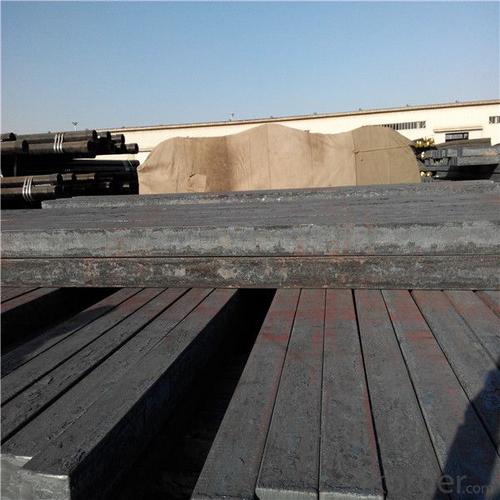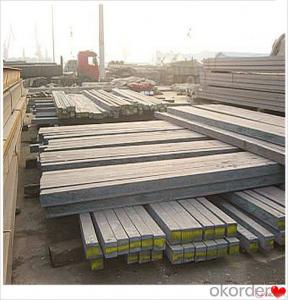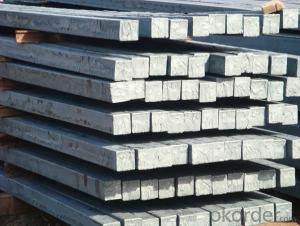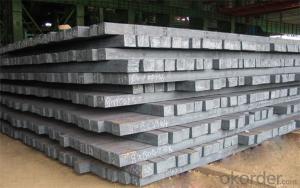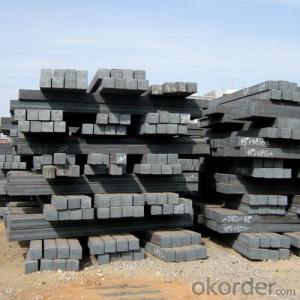Square Billets for steel products material
- Loading Port:
- China main port
- Payment Terms:
- TT OR LC
- Min Order Qty:
- 10000 m.t.
- Supply Capability:
- 14980 m.t./month
OKorder Service Pledge
OKorder Financial Service
You Might Also Like
Specification
Steel billet
(ingot) by cogging or breakdown of semifinished products, is the raw material of all kinds of steel mill.
Billet section of square, round, flat, rectangular and abnormity of several kinds of, mainly related to the
shape of rolled products.
Rectangular billet continuous casting billet and mainly general carbon steel, low carbon low silicon cold-rolled material, high quality carbon structural steel, high strength low alloy steel, special steel, etc.
The billet is mainly divided into two kinds from the shape:
Slab: cross section width and height of the ratio of the larger, mainly used for rolling plate.
Gade:
Standard | C(%) | Mn(%) | S(%) | P(%) | Si(%) |
Q195 | ≤0.12 | ≤0.50 | ≤0.040 | ≤0.035 | ≤0.30 |
Q235 | ≤0.20 | ≤1.40 | ≤0.045 | ≤0.045 | ≤0.35 |
Q275 | ≤0.22 | ≤1.50 | ≤0.045 | ≤0.045 | ≤0.35 |
20MnSi | 0.17-0.25 | 1.2-1.6 | ≤ 0.050 | ≤ 0.050 | 0.40-0.80 |
3SP | 0.14-0.22 | 0.40-0.85 | ≤ 0.050 | ≤ 0.040 | 0.05-0.15 |
5SP | 0.28-0.37 | 0.50-1.00 | ≤ 0.050 | ≤ 0.040 | 0.15-0.30 |
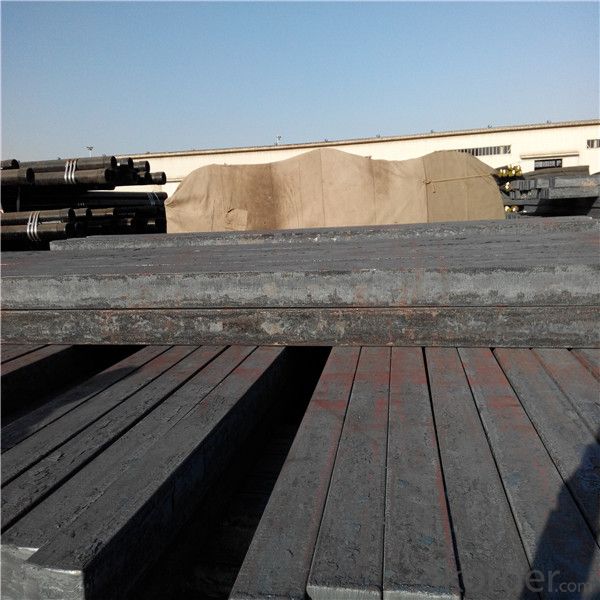
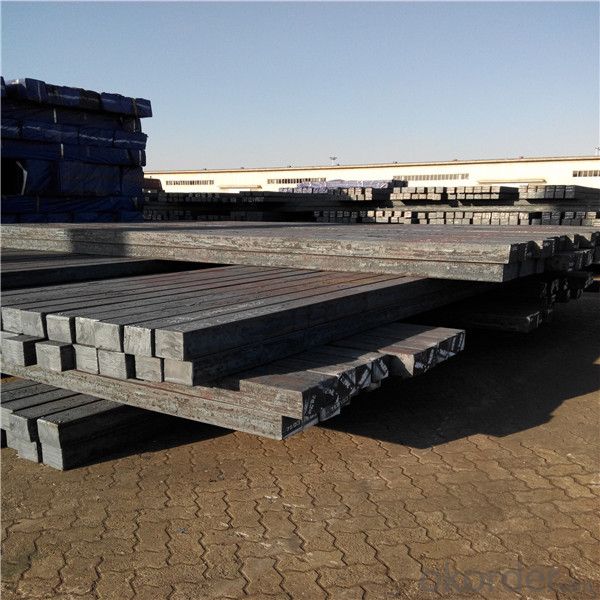
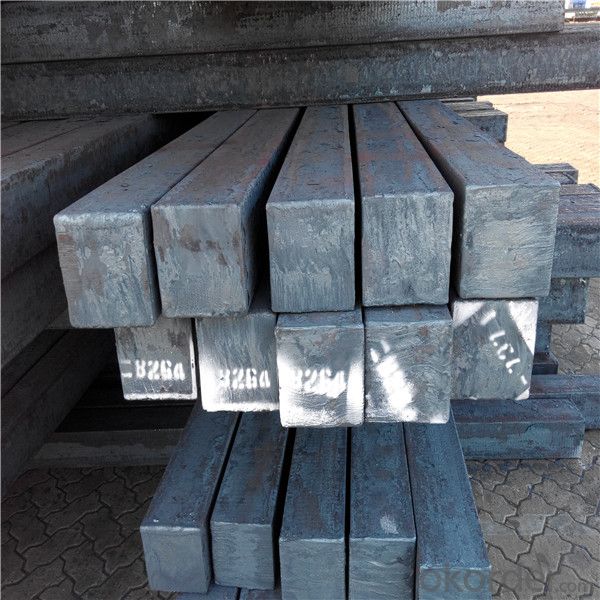

Our service :
We have a plant and professional team to provide our best service, from the start of production until the
loading into the vessel, we have a complete quality follow up procedure, to assure our products arrives to the customer with satisfaction. Welcome new and old customers
to contact us for future business relationships! We will give you a surpise price.
Packing :
Within 30 days
1.Standard export package
2.In bundles with steel strips
3.As the requirements of the customers
FAQ:
Q: What is payment terms?
A: FOB 30% T/T IN ADVANCE AS DEPOSIT AND 70% T/T BEFORE SHIPMENT
CIF and CFR 30% T/T IN ADVANCE AS DEPOSIT AND 70% T/T AS THE COPY OF B/L OR L/C AT SIGHT
Q:How to guarantee the quality of the products?
A:We have established the international advanced quality management system,every link from raw material
to final product we have strict quality test;We resolutely put an end to unqualified products flowing into the market.
At the same time, we will provide necessary follow-up service assurance.
Q:How long can we receive the product after purchase?
A :In the purchase of product within three working days, We will arrange the factory delivery as soon as possible.
The pecific time of receiving is related to the state and position of customers.
- Q: How are steel billets different from steel ingots?
- Steel billets and steel ingots are both intermediate products in the steel manufacturing process, but they differ in terms of their shape and size. Steel billets are smaller and have a square or rectangular cross-section, typically measuring less than 36 square inches. In contrast, steel ingots are larger and have a more irregular shape, often weighing several tons. Additionally, steel billets are typically produced using continuous casting methods, while steel ingots are typically made through traditional ingot casting processes.
- Q: What are the main challenges in the transportation of steel billets?
- The main challenges in the transportation of steel billets include ensuring proper handling and securing of the heavy and bulky loads, preventing damage or deformation during loading and unloading processes, and complying with safety regulations for transporting hazardous materials. Additionally, factors such as limited availability of specialized equipment, fluctuations in fuel prices, and coordinating logistics for long-distance shipments can pose challenges for efficient and cost-effective transportation of steel billets.
- Q: What are the different types of coating processes used for protecting steel billets?
- There are several different types of coating processes used for protecting steel billets. These processes aim to prevent corrosion and improve the durability of the steel billets. Some of the commonly used coating processes include: 1. Hot-dip galvanizing: This process involves dipping the steel billets into a bath of molten zinc. The zinc forms a protective layer on the surface of the steel, preventing corrosion and providing long-lasting protection. 2. Electroplating: In this process, a thin layer of metal such as zinc, nickel, or chrome is deposited onto the surface of the steel billets using an electric current. The metal layer acts as a barrier against corrosion and enhances the appearance of the steel. 3. Powder coating: Powder coating involves applying a dry powder onto the surface of the steel billets, which is then heated to form a protective layer. This process provides excellent resistance to corrosion, chemicals, and UV rays. 4. Thermal spray coating: This process involves spraying a melted or heated material onto the surface of the steel billets. The coating material can be metal alloys, ceramics, or polymers. Thermal spray coatings offer high wear resistance, corrosion protection, and thermal insulation. 5. Paint coating: Applying paint onto the surface of steel billets is a common method of protection. The paint acts as a barrier against moisture and atmospheric elements, preventing corrosion and maintaining the appearance of the steel. Each of these coating processes has its own advantages and is suitable for different applications. The choice of coating process depends on factors such as the desired level of protection, environmental conditions, and cost considerations.
- Q: How long do steel billets last?
- The lifespan of steel billets can vary depending on various factors such as the quality of the steel, storage conditions, and usage. Generally, steel billets can last for decades if stored properly and used within their recommended lifespan.
- Q: What is the role of steel billets in the construction of dams and reservoirs?
- The role of steel billets in dam and reservoir construction cannot be overstated. These semi-finished steel products are vital for manufacturing various components and structures necessary for the construction process. A primary application of steel billets in dam and reservoir construction is their use in producing reinforced concrete. Reinforced concrete combines the strength and durability of steel with the versatility and moldability of concrete. Steel billets are utilized to create steel reinforcement bars, commonly called rebars, which are embedded within the concrete to improve its tensile strength and prevent cracking when subjected to heavy loads. These rebars provide the necessary structural support for the dam or reservoir, ensuring its stability and long life. Furthermore, steel billets are essential for fabricating gates, penstocks, and other mechanical components required for dams and reservoirs. These components play a crucial role in regulating water flow, controlling water levels, and managing the release of water from the reservoir. Steel billets are forged, rolled, or machined to manufacture these specialized components, guaranteeing their strength, reliability, and resistance to corrosion. Moreover, steel billets are indispensable in constructing spillways, which are designed to safely discharge excess water from reservoirs during periods of heavy rainfall or floods. Spillway gates, channels, and other structures are often made from steel billets because they need to withstand high water pressure and turbulent flow conditions. To summarize, steel billets are vital in dam and reservoir construction. They are instrumental in producing reinforced concrete, thereby providing structural support and enhancing the overall strength of the structure. Steel billets are also used in the production of gates, penstocks, spillways, and other mechanical components, ensuring the efficient operation and long-term durability of these crucial water management infrastructures.
- Q: What is the role of steel billets in the manufacturing of storage tanks?
- Steel billets play a crucial role in the manufacturing of storage tanks. These billets serve as the primary raw material for the construction of the tank's structural framework. They are essentially semi-finished steel products that are cast into a specific shape and size, typically in a rectangular or square form. The primary reason for using steel billets in the manufacturing of storage tanks is their exceptional strength and durability. Steel is renowned for its high tensile strength, which allows the tank to withstand the immense pressure and weight of the stored contents. Additionally, steel is resistant to corrosion, making it an ideal material for storage tanks that may hold various liquids or gases. Steel billets are also preferred for their malleability and versatility. They can be easily molded and welded into the desired shape, allowing for the customization of storage tanks to meet specific requirements. The flexibility of steel billets enables the construction of tanks of various sizes and capacities, accommodating different storage needs in industries such as oil and gas, chemical processing, water treatment, and many others. Furthermore, steel billets offer cost-effectiveness in the manufacturing process. The abundance of steel as a raw material and its recyclability contribute to lower production costs, making steel tanks a more economical choice compared to tanks made from other materials. Moreover, the longevity of steel tanks reduces maintenance and replacement costs over time, ensuring a higher return on investment for industries relying on storage tanks. In conclusion, steel billets play a vital role in the manufacturing of storage tanks due to their strength, durability, corrosion resistance, malleability, and cost-effectiveness. These billets form the core framework of the tanks, providing the necessary structural integrity to safely contain and store various liquids or gases. By utilizing steel billets, industries can rely on robust and reliable storage solutions that meet their specific storage requirements.
- Q: What is the average lead time for ordering steel billets?
- The lead time for ordering steel billets can vary depending on several factors, including the supplier, quantity needed, production capacity, and current market conditions. Typically, the lead time can range from a few weeks to a couple of months. If the supplier has readily available stock or a short production cycle, the lead time may be shorter, usually around two to four weeks. However, if the supplier needs to produce the steel billets specifically for the order, it may take longer. In such cases, the lead time can extend to six to eight weeks or even longer, particularly if there are any production process delays. Considering the quantity required is also crucial. Smaller orders may have shorter lead times compared to larger quantities, as they can be accommodated within the supplier's existing production schedule or available stock. Furthermore, market conditions play a significant role. When there is high demand or disruptions in the supply chain, lead times may increase due to heightened competition for resources and longer production cycles. To obtain an accurate estimate of the average lead time for ordering steel billets, it is advisable to contact multiple suppliers and discuss your specific requirements with them. They can provide more precise information based on their production capabilities and the current market conditions.
- Q: Can steel billets be used in the production of bicycles?
- Certainly! Bicycles can indeed utilize steel billets in their production. Steel billets, which are partially finished products derived from steel, can undergo further processing to attain a wide range of shapes and sizes. When it comes to bicycles, these steel billets can be molded and fashioned into diverse components such as frames, forks, handlebars, and other structural elements. Steel remains a popular choice for bicycle production due to its commendable attributes of strength, durability, and cost-effectiveness. It offers exceptional rigidity, stability, and resistance to deformation, rendering it suitable for various bicycle types including road bikes, mountain bikes, and hybrid bikes. Furthermore, steel can be readily welded, enabling customization and facilitating the repair of bicycle frames.
- Q: Reasons and treatment methods of billet stripping in continuous casting
- The main reason for the stripping is that the slab is not uniformly cooled in the mold, which results in uneven thickness of the shell, which results in uneven shrinkage, which leads to the unevenness of the billet. If the mould outlet, two cold area is uneven, the shell support is not full, it will make breaking-off intensified;
- Q: What are the potential applications of steel billets in the transportation sector?
- Due to their strength, durability, and versatility, steel billets offer a wide range of potential applications in the transportation sector. One primary use is in the manufacturing of various vehicle components, such as engine parts, suspension systems, axles, and other critical parts that require high strength and resistance to wear and tear. Moreover, steel billets can be utilized in the construction of railway tracks, bridges, and tunnels. With its high tensile strength, steel is an ideal material for infrastructure projects as it can withstand heavy loads and provide long-lasting performance. It is also suitable for manufacturing shipbuilding components like hulls, propellers, and deck structures, offering excellent corrosion resistance and structural integrity in marine environments. Additionally, steel billets find use in the production of transportation equipment like trailers, trucks, and buses. Its strength and durability make it an ideal material for constructing the chassis and frames of these vehicles, ensuring their safety and longevity. In the automotive industry, steel billets are commonly used for producing car bodies and frames. The lightweight yet robust characteristics of steel make it a preferred choice for enhancing fuel efficiency and crashworthiness in vehicles. Furthermore, manufacturers can shape steel billets into intricate designs, allowing them to create aesthetically pleasing and aerodynamic vehicle structures. In conclusion, the strength, durability, and versatility of steel billets make them essential in the transportation sector. They are used in various applications, ranging from vehicle components to infrastructure projects. By ensuring safety, reliability, and longevity, steel billets play a vital role in the industry.
Send your message to us
Square Billets for steel products material
- Loading Port:
- China main port
- Payment Terms:
- TT OR LC
- Min Order Qty:
- 10000 m.t.
- Supply Capability:
- 14980 m.t./month
OKorder Service Pledge
OKorder Financial Service
Similar products
Hot products
Hot Searches
Related keywords


